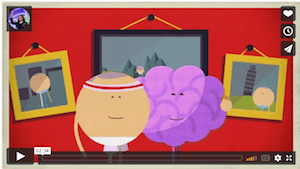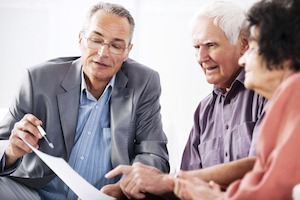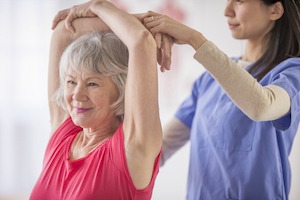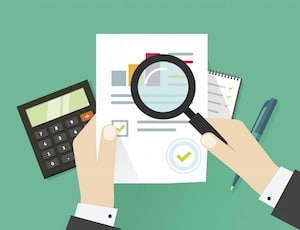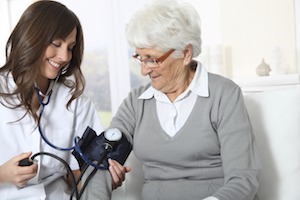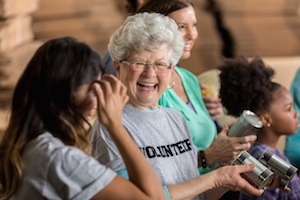September is Healthy Aging Month, and as a celebration of this, we are exploring the benefits of yoga for seniors. Why is it beneficial to practice yoga as we age? Because as our body ages, our joints begin to lose their range of motion, and our muscles start to stiffen. The body also becomes more susceptible to chronic problems, such as heart disease, diabetes, cancer, osteoporosis and arthritis.
Yoga can help ease and even slow down these changes in the body by keeping muscles supple, limbs more flexible, reducing swelling in joints, increasing mobility and strength, and improving balance and stability. Practicing yoga can also aid in improving your alertness, mood, sleep, digestion, as well as relaxing the body and the mind.
Here are several poses to assist with your stability, strength, balance and overall well-being:
Tree Pose
Stand tall and place your right foot onto the left leg - either on the calf (just below the knee) or on the ankle with the toes propped against the floor - depending on your flexibility. Press your foot firmly into the leg, and the leg into the foot for stability, then open your right knee out to the side to open the hip without tilting your pelvis. Bring your hands to a prayer position at your chest and stay here for five to ten deep breaths. Repeat on the left side.
Tree Pose is great for building leg and abdominal strength. It also assists in improving overall balance and concentration. Another alternative is using a chair for added support, or standing with your back against a wall.
Mountain Pose
Stand tall with your feet touching together. Find even balancing between your feels and your toes. Actively engage your Quad muscles to feel your kneecaps lift. Draw your navel in toward your spine to firm up your abdominals and keep your spine and pelvis neutral - no tucking or arching. Activate the fingers and reach them straight down to draw your shoulders away from your ears. Lift up through the crown of your head and the back of your neck. Breathe here for five to ten breaths. Close your eyes if possible and work to maintain balance.
Variations: If you want to take it further, try reaching the arms up overhead, taking the palms together with arms extended long, and maintaining the engagement in the core and neutrality in the spine and pelvis. This pose can also be done seated for more support.
Mountain Pose helps with balance and grounding through the feet, keeping the feet healthy. This pose allows the body to build stability and focus. It also builds back strength and helps with posture.
Bird Dog
Start by kneeling in a table top position, with hands directly under shoulders and knees directly under hips (Place blankets or cushions under knees if you need extra support). Draw your belly in towards your spine. Press the hands firmly into the mat and broaden the shoulder blades on the back. Reach one arm forward and the opposite leg back, keeping your arm and leg in line with your body. Imagine you have a glass of water balancing on your back, and you have someone tugging you forward from your hand and backwards from your foot so that you are actively reaching in both directions. Stay for a few breaths then switch sides. Repeat five to ten times. Take breaks.
Bird Dog is good for strengthening the transverse abdominals and for overall back support. The health and wellness of the spine is very important as the body ages. This pose, if done on a regular basis, allows for maintenance of a healthy spine, relief of low-back pain, and increase of strength and balance.
Sphinx
Lie down on your stomach with legs long behind you. Prop your upper body up onto your forearms, with your elbows under your shoulders and your hands extending straight in front of you, fingers flared. Press down firmly into your forearms, drawing your shoulder blades away from your ears, broadening your collarbones, and lifting through the crown of your head. Lift your abdominals up, imagining lifting your belly button off the mat. Gently squeeze the sitting bones together. Stay here for five to ten breaths, and then release all the way down onto your stoamch. Repeat one to two more times.
Variations: If there is any pinching in the low back, try sliding your elbows further away from you to lessen the back bend. Also focus on squeezing the sitting bones together and engaging the inner thigh muscles.
Sphinx Pose is gentle enough on the body at any age. This pose does a wonderful job of opening up the chest and working on the upper back and core strength, and relieving low back pain.
Bada Konasana
Sit on your bottom and bring the soles of the feet in to touch, allowing the knees to drop out to the side and the hips to open. Place your hands around your feet and begin to fold forward toward your feet for a deeper stretch. Hold for five to ten breaths.
Variations: If you need more assisted with this pose, put your back against the wall for support, or try placing blocks or pillows under your knees.
This pose is a great way to work on opening the hips and keep the joints mobile. This pose is good for the health of the prostate for men and the reproductive system for women. The longer you hold this pose the better it is for the body.
Savasana
Lie down on your back with you legs out long and your arms by your sides, palms facing up. Let the floor support your whole body. Completely relax the muscles, let go of all of your effort in your muscles, let go of your thoughts and breathe normal, listening to the sound of your breath. Lay in this pose as long as you need.
Savasana is the most restorative pose you can take. It is typically at the end of all yoga series to ensure that you relax, reflect and restore your mind, body and soul at the end of your practice. It resets your nervous system and helps with restoring peace with in.
It is important to practice regularly, 2-3 times a week if possible. Yoga is an amazing exercise for the overall body and it will help keep you healthy. It can play a huge part physically, mentally and emotionally. Because seniors experience a higher rate of anxiety and depression, yoga allows the body and mind to relax, slow down, and build strength and focus. Yoga encourages mindfulness, improves respiration, blood flow and cardiovascular health, can reduce high blood pressure, assist in a speedier recovery from surgery, help with the grieving process, and reduce chances of a fall. So in short, DO MORE YOGA.
If you or your loved one could use help staying active and healthy as you age, consider bringing a qualified care provider into your home. American In-Home Care always refers qualified, screened, care providers that are compassionate and ready to help with services like meal preparation, diet monitoring, and mobility assistance. Contact us at 1-844-505-0004 to schedule your free in-home consultation to discuss which care options are right for you and your family.

